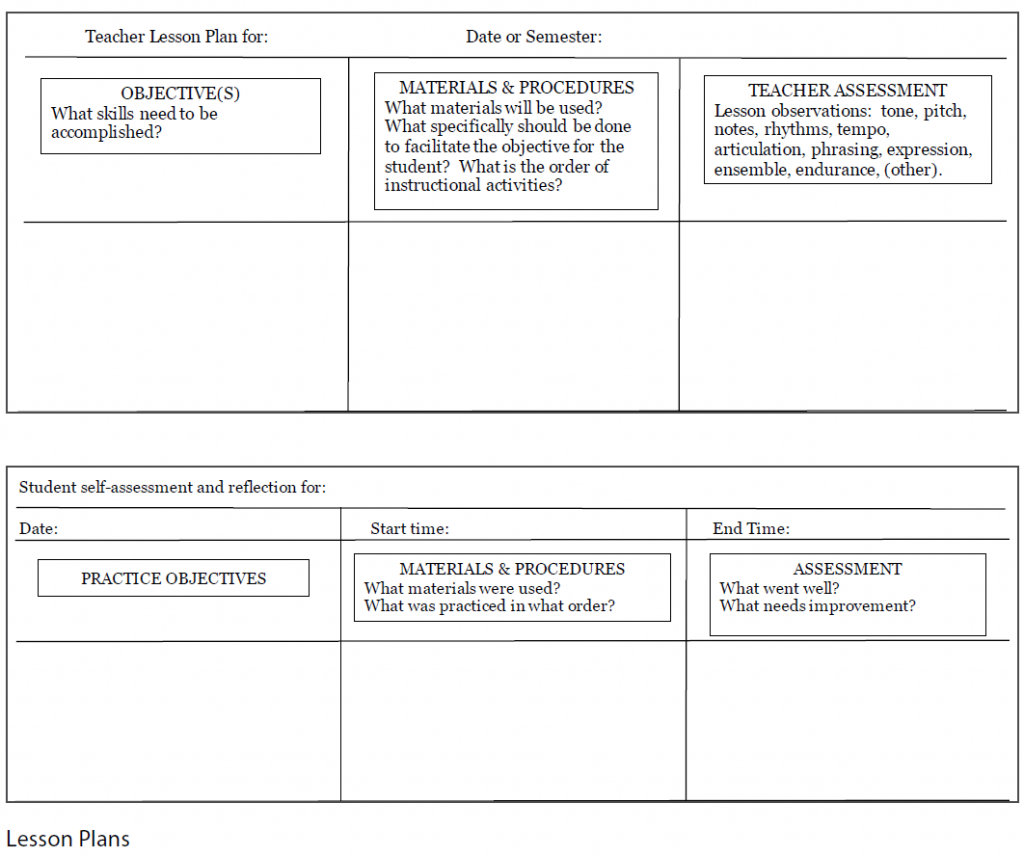Originally published in The Clarinet 46/3 (June 2019). Printed copies of The Clarinet are available for ICA members. 
Pedagogy Corner
Teaching Effectively: Suggestions for Applied Lesson Teachers
by Paula Corley, ICA Pedagogy Chair
What is highly effective applied teaching? There are many approaches but no predetermined models for perfect private instruction. Whether at the college level or middle school level, one-on-one instruction is complex and multidimensional. Students must learn to relate to the teacher without the support of classmates, while teachers try to build skill, self-esteem and motivation, one student at a time. In short, a teacher’s musical knowledge and artistic ability may not be enough to facilitate student achievement. Research identifies these common practices for effective teaching:
1. Make your expectations clear.
Teacher clarity is the number-one most effective teaching strategy. Many teachers use a syllabus with goals, objectives and learning outcomes to facilitate instructional clarity. However, a syllabus alone will not insure student success. Teachers should develop specific weekly plans with clear objectives that can be observed and measured. It is only through the systematic achievement of well-designed objectives that long-term goals can be accomplished.
Here is an example of a lesson objective:

The objective represents one component of a larger composite goal, and the specificity helps students focus their practice efforts.
2. Teach your students how and what to practice.
Music practice is a widely studied topic and many writers agree that ideas regarding effective practice techniques should evolve to accommodate current students. Self-regulated practice is a model that includes measurement for cognition (thought) and affect (feelings), not just the action of playing one’s instrument.
First, specify materials to be practiced and the how to practice them. Here is an example:

Help students choose appropriate materials and identify practice strategies, such as finger isolation, tempo modifications, rhythmic variations, etc.
Encourage self-reflection strategies to teach problem-solving skills. Ask students to make notes at each practice session, both positive and negative. Engage students in discussion about practice, focusing on problem-solving and diagnostic skills. Research suggests that error-making is necessary for eventual understanding; however, students should work to find solutions instead of just recognizing the mistakes.
3. Give and receive feedback often.
Feedback should be formative (each lesson) and not reserved for graded performances. Keep exchanges constructive and musically focused.
Allow adequate time for student performance before feedback begins. Maintain balance between verbalization and active engagement. Covey advises us to be aware of “our own needs for rightness” and to not allow teaching to become a collection of monologues.1 Eyler found that continual lecturing negatively impacts learning.2 When information delivery is passive, attention span is decreased and the brain moves elsewhere for stimuli. De Bruin, however, advises us to watch for differences in student disposition and recognize that some students require less verbal incentive while others need more.3
Provide honest assessment without judgment. Assessment is an important component of effective teaching and is different from evaluation. Assessment is the process of observing student performance with the intention of reinforcing instruction. Evaluation is a judgment, usually against a standard. Identify aspects of student performance that need improvement. An example would be “Today I noticed endurance is an issue” instead of “Your endurance is really poor today.” Non-judgmental assessment and positive feedback will help students maintain their efforts. You can download these lesson plans below for yourself.
Click HERE and HERE for PDF files of the lesson plans.

4. Facilitate good interpersonal relationships.
Interpersonal relationships have a significant impact on student learning, motivation and achievement, and a teacher can strongly affect a student’s self-esteem and identity development in the one-on-one environment. Personal biases, beliefs and social interaction impact the instruction, and students may perceive words and behaviors differently than teachers. It is important to recognize that a teacher’s intention can easily be misperceived, especially in written and verbal communication. Simple non-verbal cues, such as the sound of the voice or body language can derail or enhance a teacher’s intent.
Interpersonal relationships are built on trust and sincerity. Effective teachers are genuine, not what others expect or want us to be.4 Pierson in her Ted Talk video said: “Every student deserves an adult who will never give up on them, who understands the power of connection and insists that they become the best they can possibly be.”5
Further Reading
Alber, R. (2015). Five Highly Effective Teaching Practices. www.edutopia.org
Colvin, G. (2010). Talent is Overrated: What Really Separates World-Class Performers from Everybody Else. Portfolio, Penguin Random House LLC, New York.
Concina, E. (2015). “Music Education and Effective Teaching: Perspectives from a Critical Review.” Literacy Information and Computer Education Journal.
Duke, B. (2005). Intelligent Music Teaching: Essays on the Core Principles of Effective Instruction. Learning and Behavior Resources, Austin.
McPhearson, G. et.al. (2019). “Applying Self-Regulated Learning Microanalysis to Study Musicians’ Practice.” Psychology of Music.
Endnotes
1 S. Covey, The 7 Habits of Highly Effective People: Powerful Lessons in Personal Change (Free Press, 1989).
2 J. Eyler, How Humans Learn: The Science and Stories Behind Effective College Teaching (West Virgina University Press: Morgantown, 2018).
3 L. Debruin, “The Use of Cognitive Apprenticeship in the Learning and Teaching of Improvisation: Teacher and Student Perspectives,” Research Studies in Music Education, 2019.
4 Covey, The 7 Habits.
5 R. Pierson, “Every Kid Needs a Champion,” Ted Talks, www.ted.com, 2013.
About the Writer

Paula Corley is a Texas music educator whose passion is clarinet. She is the “mayor” of Clarinet City (www.clarinetcity.com), pedagogy chair for the International Clarinet Association and the clarinet instructor at Texas Lutheran University in Seguin. The author of two books for developing clarinetists, Paula has appeared at over 40 music conferences throughout the United States. She is a performing artist and clinician for Vandoren and Buffet Crampon, and is featured in the “Play Wind” app developed by Buffet Crampon Paris.
Comments are closed.